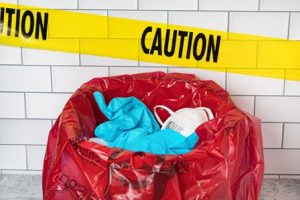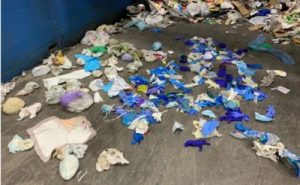Plastic Footprint during COVID-19 Pandemic
All these PPE wastes need attention of authorities like Central and State Pollution Control Boards and municipalities for safe disposal.
The plastic footprint is a similar metric, which is only used to judge how much plastic our lifestyle will contribute to the worldwide trash pile. If we are serious about reducing our  carbon footprint, then the best way to start is by reducing our plastic footprint. Producing plastic creates carbon dioxide. Using five plastic bags at the grocery store adds one kilogram of carbon dioxide to our carbon footprint. It is estimated that it takes more than 500 years for plastic to degrade. Millions of gloves, masks and other forms of Personal Protective Equipments (PPEs) are observed to be used worldwide to protect ourselves from the deadly COVID-19 virus, which are then thrown away every day as such increasing our plastic footprint.
carbon footprint, then the best way to start is by reducing our plastic footprint. Producing plastic creates carbon dioxide. Using five plastic bags at the grocery store adds one kilogram of carbon dioxide to our carbon footprint. It is estimated that it takes more than 500 years for plastic to degrade. Millions of gloves, masks and other forms of Personal Protective Equipments (PPEs) are observed to be used worldwide to protect ourselves from the deadly COVID-19 virus, which are then thrown away every day as such increasing our plastic footprint.
Disposal of PPE waste correctly and safely is an important part of the overall safety programme of any medical facility. Most of these waste PPEs contain plastic as ingredients.These wastes may be consumed by land animals like cows, dogs, goats, etc.,which can prevent their food digestion and can lead to a very slow and painful death.Waterlogged masks, gloves, hand sanitiser bottles and other corona virus-related waste are already being found on our seabeds. They are washed up on our beaches, joining the day-to-day detritus into the ocean water. Every year, about 300 million tonnes of plastic is produced and 5 to 13 million tonnes of it gets washed into the ocean, according to the 2015 data. It has been analysed that about 269,000 tonnes of the plastic floats in the ocean currents. Coronavirus-related waste has become a new form of pollution, in addition as single-use PPEs flood our ocean.
Also Read : Call for Single-Use Plastic Free India
As larger plastic debris breaks into smaller pieces, birds, turtles, and fish mistake it for food and gobble it up, which can perforate their stomachs, damage their intestines, or deprive them of nourishment, leading to starvation. Marine mammals and turtles commonly consume the discarded hand gloves resembling jelly fish.
Over the years, plastic has emerged as one of the major reasons behind the death of many cows and other animals in India.
One of the biggest reasons behind it is the people who throw away food waste inside plastic bags (polythene bags) without any hesitation. Ingestion of plastic materials may not result in immediate death, but there are several difficult symptoms seen in the victim animals. These plastics are indigestible and therefore pile up in their stomachs (rumen for cattle) with time and get entangled with different materials, forming hard cement like ball. After some time, the animal shows signs of being weak and tired then goes off feed and at times experiences bloat due to stomach blockage. As a symptom the animal may also start drinking a lot of water. In one such case, doctors in Patna managed to remove 80 kg of plastic waste from the stomach of a cow. In another incident at Bhubaneswar OUAT veterinarians surgically removed more than 70 kg of plastic from a bull’s stomach.
with time and get entangled with different materials, forming hard cement like ball. After some time, the animal shows signs of being weak and tired then goes off feed and at times experiences bloat due to stomach blockage. As a symptom the animal may also start drinking a lot of water. In one such case, doctors in Patna managed to remove 80 kg of plastic waste from the stomach of a cow. In another incident at Bhubaneswar OUAT veterinarians surgically removed more than 70 kg of plastic from a bull’s stomach.
Also Read : The crisis of Marine Pollution: Oceans turning into plastic soup
One study estimates that in the UK alone, if every person used a single-use face mask a day for a year, it would create an additional 66,000 tonnes of contaminated waste and 57,000 tonnes of plastic packaging. Humans live on land, but they suffer from marine pollution too. The trash we toss away comes back to us, and as the masks example above demonstrates, it only takes a few weeks. Plastic leaches into our drinking water; too—research found that we consume a spoonful of plastic a week. The microscopic plastic dissolved in the ocean water; interfere with the food chain, which can be fatal.All these PPE wastes need attention of authorities like Central and State Pollution Control Boards (PCBs) and municipalities for safe disposal.
